


Ann Dumas in Giverny.
by JULIET RIX
Ann Dumas has been a curator at the Royal Academy of Arts for two decades and is described by its artistic director, Tim Marlow, as world class. She spent a decade in New York before joining the RA and now divides her time between London and her latest role, as consultant curator of the European collection at the Museum of Fine Arts, Houston. A specialist in French art of the 19th and early 20th century, Dumas has been responsible for a multitude of high-profile international exhibitions, including such popular UK hits as Painting the Modern Garden: Monet to Matisse (2016), Matisse: His Art and His Textiles (2005) and The Real Van Gogh: The Artist and His Letters (2010).
Dumas studied at the Courtauld Institute, University of London, where her dissertation was on the private art collection of Edgar Degas. On graduation, she was awarded a Hilla von Rebay research fellowship at the Guggenheim Museum, New York, also working on surrealist paintings in the Peggy Guggenheim Collection in Venice. After a brief spell at the Metropolitan Museum of Art, she spent six years as associate curator at the Brooklyn Museum, before returning to her native UK in 1999 to take up her post at the RA. Last year, she was awarded an MBE for services to the arts.
We meet in the Academicians room of Burlington House shortly after the appointment of the Royal Academy’s first female president, Rebecca Salter, and as Dumas is hanging her next show, Picasso and Paper, which opens on 25 January.
Juliet Rix: The RA has just appointed its first female president in its 250-year history. Will it make a difference?
Ann Dumas: I think so. This has been a very male-dominated institution since its founding in the late-18th century. I don’t know Rebecca well, but I admire her and I think she will bring a different approach. I can’t say quite how, but it won’t be that boy network.
Although, it should be said, the programming of a lot of female artists recently, and particularly in the coming year, was very much down to a decision made by Tim Marlow [the artistic director at the RA from 2014 to 2019]. A lot of people felt we needed to show more women and he made it happen.
JR: The 2020 programme does, indeed, showcase female artists more than ever before and, at its launch, Marlow said of the RA’s history of exhibiting women: “Our record is appalling … although better than many.”
AD: It has been a long time coming. When the RA was founded in 1768 there were two female founding academicians – Angelica Kauffman and a flower painter called Mary Moser. There weren’t any other female RAs for about 100 years. In the past five years, though, more women than men have been elected as RAs. It’s in the zeitgeist.
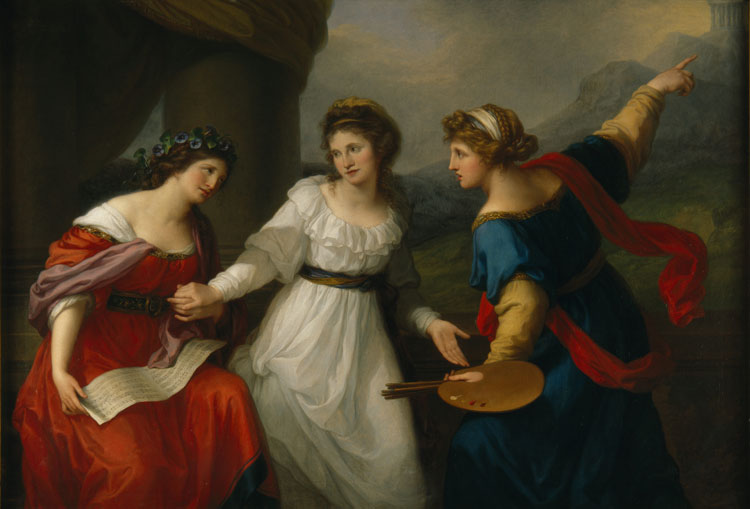
Angelica Kauffman, Self-portrait of the Artist hesitating between the Arts of Music and Painting, 1794. Oil on canvas, 147.3 x 215.9 cm. Nostell Priory © National Trust Images/John Hammond.
It is, in part, a fact of history that there were far fewer female than male artists (I don’t think that is true now). You can’t change that, and you also can’t show an artist just because they were a woman – you have to keep up artistic standards. It is very difficult for somewhere like the National Gallery. There’s Artemisia Gentileschi (and it is doing an exhibition of her work this year), but otherwise there aren’t many female artists in its period.
There are a lot of good female artists now. It is easier for the Tate (with its modern/contemporary collection) and it has recently had quite a few shows by women.
JR: Has that been partly down to the leadership of Frances Morris at Tate Modern?
AD: Yes, and Maria Balshaw [director of Tate]. Our [RA] programme for this year is really interesting. We have a big Marina Abramović show in the autumn. It’s her first major exhibition in Britain and the first single-artist show by a woman in our main galleries. So that’s a landmark.
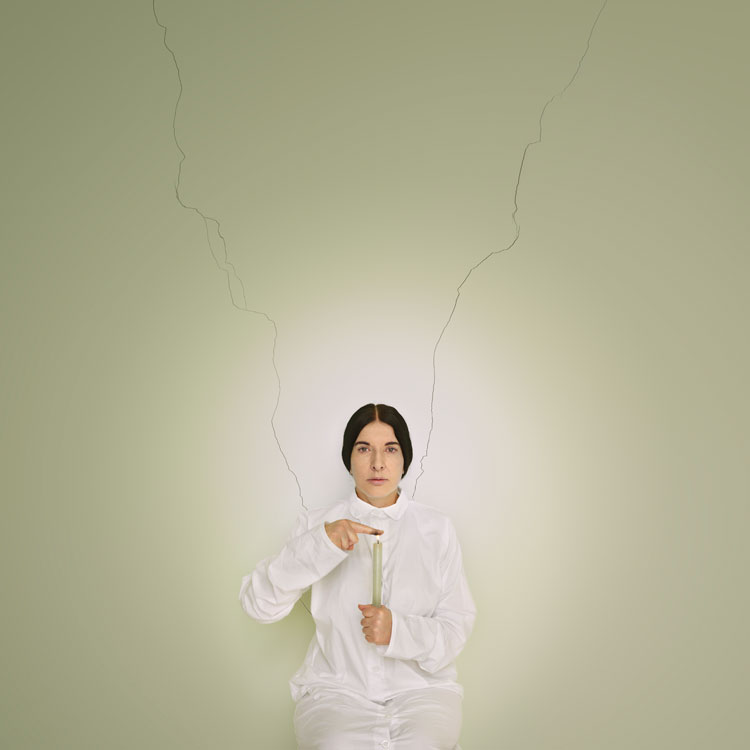
Marina Abramović, ‘Artist Portrait with a Candle (C)’, from the series Places of Power, 2013. Fine art pigment print. Brazil. Courtesy of the Marina Abramović Archives © Marina Abramović.
And, in the summer, we have Angelica Kauffman, a really distinguished female artist of an earlier period. She came to England in the 1760s just before the founding of the Academy. She did well with portraits, but also did huge history paintings – very sought-after at the time – with quite masculine subjects. Interestingly, a number of her patrons were women, the most notable being Catherine the Great. A lot of Kauffman’s works are now in the Hermitage in St Petersburg. A few pieces are coming from there for this show, as well as from America and Italy. This is the first major international exhibition of her work, certainly since the 19th century.
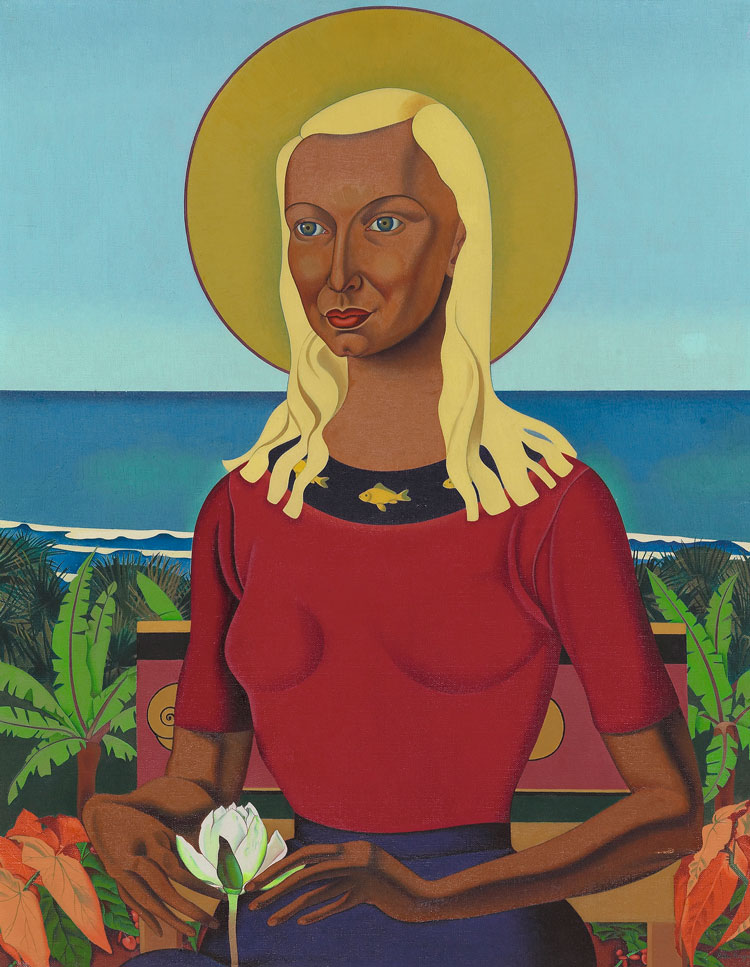
Rita Angus, Rutu, 1951. Oil on canvas, 71.5 x 56 cm. Collection of the Museum of New Zealand Te Papa Tongarewa, Wellington. Purchased 1992 with New Zealand Lottery Grants Board funds © Reproduced courtesy of The Estate of Rita Angus.
We are also showing a New Zealand female artist, Rita Angus. She was an early 20th-century artist who completely reinterpreted the way of looking at and painting New Zealand – breaking free of colonial roots and nostalgia for Great Britain. She was a fiercely independent woman with a very original style, celebrating the extraordinary beauty of the New Zealand landscape. She isn’t known here at all, but she is very highly rated in New Zealand.
Also, this autumn we have Tracey Emin / Edvard Munch (her favourite artist) and 80% of the show is actually Emin and about 20% Munch.
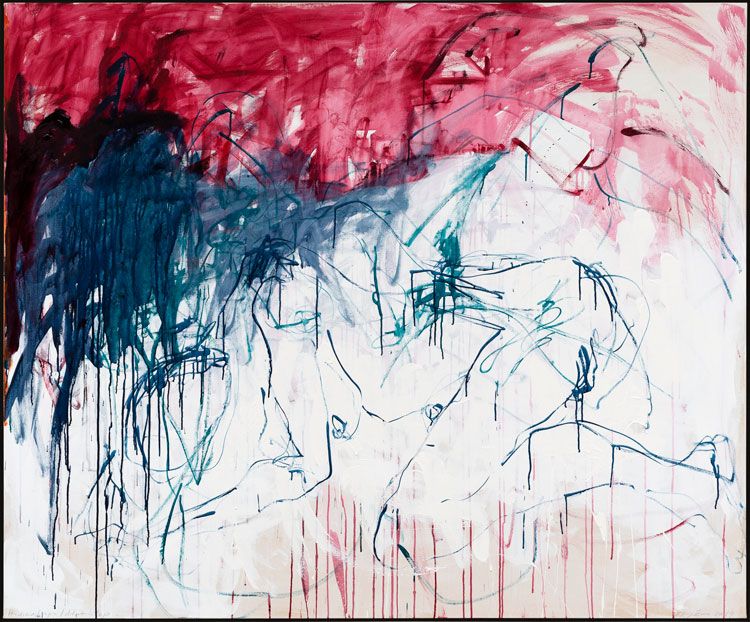
Tracey Emin, It - didnt stop - I didnt stop, 2019. Acrylic on canvas, 152 x 183.5 x 3.7 cm. Photo © HV-studio Courtesy the Artist and Xavier Hufkens, Brussels.
That’s quite a spread of female artists in one year. There are more being planned now. I can’t talk about them yet, but there is an intention is to keep up this programming of female artists.
JR: You have said in the past that history of art courses are often seen as a soft option and populated with girls from well-off backgrounds and that this has not always served women in the art world well. Do you think that is still the case?
AD: I think the “Sloane” effect is much reduced. There are a lot of young women in my office and none of them is characteristically Sloane. In fact, they are quite international, something I very much hope will not be lost after Brexit.
JR: How do you think the gender balance is generally in the art world now? Is it still male-dominated?
AD: It is still male-dominated at the top, but there are lots of women in more junior roles. My office here is 90% women. There are more women in senior roles than there used to be and, in curating, it may even be balanced.
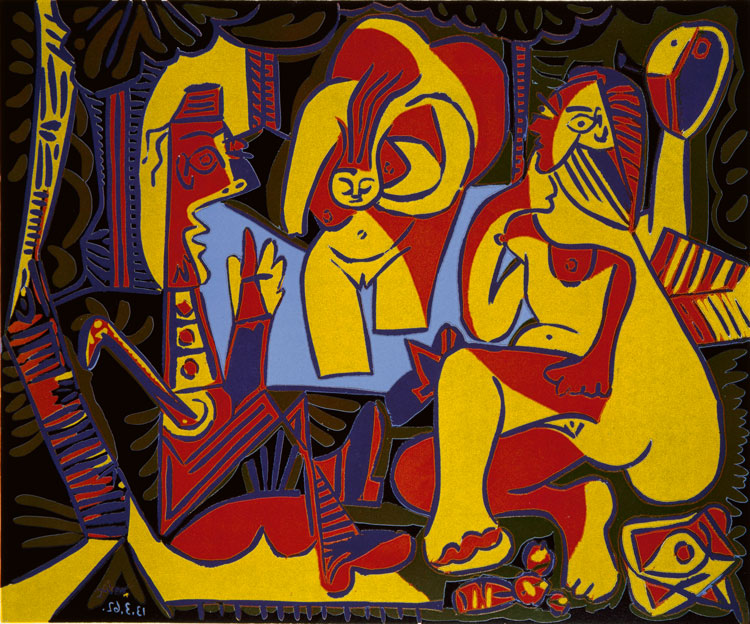
Pablo Picasso, ‘Le Déjeuner sur l’herbe’ after Manet, I, Mougins, 26 January–13 March 1962. Linocut, fifth state. Artist’s proof on Arches wove paper, printed in six passes in purple, yellow, red, green, blue and black, 62 x 75.2 cm. Musée national Picasso-Paris. Pablo Picasso Gift in Lieu, 1979. MP3488. Photo © RMN-Grand Palais (Musée national Picasso-Paris) / Marine Beck-Coppola. © Succession Picasso/DACS 2019.
JR: Do you think you have had to work harder than a man to get where you are?
AD: Possibly. I’ve certainly worked pretty hard, but the men do, too. Certainly, I’ve never worked with a man who I felt put me down for being a woman.
JR: Is the gender balance any different in the US?
AD: No, not really … Although, thinking about it, there are quite a lot of women in senior roles in Houston.
JR: And in other ways, do you find it very different working in Houston from your work here?
AD: It is different. Houston is a very impressive museum. It has a much larger staff than here and a very diverse collection (Islamic art, Asian, European – my area – photography, and a very, very good Latin American section). The RA collection is entirely made up of work by the Royal Academicians. Each new academician has to give a piece of work to the collection. The RA doesn’t buy, whereas Houston acquires all the time. There’s more money in the US. It is constructing a new building, too, for the modern and contemporary art. It is a much less eccentric place than the RA, more formal.
-Goupil,-1896.jpg)
Paul Gauguin, Portrait of a Young Woman, Vaïte (Jeanne) Goupil, 1896. Oil on canvas, 75 x 65 cm. © Ordrupgaard, Copenhagen. Photo: Anders Sune Berg.
Here (at the RA) we are short of office space, so it is very open plan – we are all in together. My Houston colleagues are horrified. There, we all have our own huge offices. There are advantages and disadvantages. Here, if you need peace to write, you have to go to the library or work from home. But it’s very collegiate. We help each other, exchange ideas. And we all get on very well. With experts in all sorts of fields, you can pick up a lot in the course of a day.
JR: Is the visiting public different?
AD: Yes. Houston is now the third or fourth largest city in America and it is very diverse. London is too, but Houston is not a tourist destination, which London is. In Houston, it is the same audience coming back all the time, so we have to keep programming new things. We have our core audience here, too, of course – our very important, wonderful RA Friends – but we also get a lot of foreign visitors.
JR: Does that affect how you curate?
AD: Yes. In Houston, you have to do shows that are really going to get through to people.
JR: They have to be very accessible?
AD: Yes. I am working on a Picasso show there as well as here. The Houston one is much smaller and is on Picasso and Alexander Calder, the American kinetic sculptor. The show has already been in Paris and it’s very visually appealing and exciting. An academic exhibition about a little-known Renaissance artist, for instance, wouldn’t work there. I’m not putting them down. They are very interested and engaged. And my recent lectures drew a very enthusiastic audience. People kept coming up to me afterwards saying: “I had no idea you could get so much out of a painting.”
Here, we can introduce lesser-known artists (such as Rita Angus), but every couple of years we do need to do a blockbuster – otherwise we’d make too big a loss. So, now we are doing Picasso. You can’t get much more blockbuster than that, but we always try to do something that is serious and scholarly, and even with an artist as thoroughly worked over as Picasso, something original.
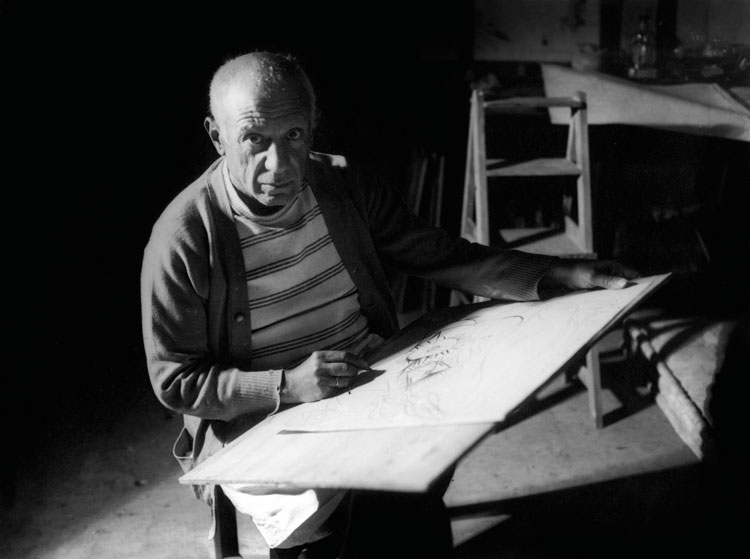
Pablo Picasso drawing in Antibes, summer 1946. Black-and-white photograph. Photo © Michel Sima / Bridgeman Images. © Succession Picasso/DACS 2019.
JR: It must be interesting working on Picasso in the RA’s year of female artists. He might not have done too well in the era of #MeToo?
AD: [laughing] No, he wouldn’t. I don’t think he was quite as bad as he might at first seem, though. He certainly had a lot of relationships with women, but he tended to stay with them for a decade or so. They did nearly always overlap and there were other casual ones alongside and I think he was pretty ruthless in the way he abandoned them when he found somebody new. Fortunately for me as the curator, this [RA] show about Picasso really isn’t about his private life, thank God.
The women are represented in the exhibition, though, because, as his grandson, Olivier, wrote in his biography of his grandfather, everything in Picasso’s life was about his art. I think these women really were muses in the fullest sense of the word, and when a woman burnt out as a source of inspiration, he was driven to find another woman, like another artist might find a new landscape. It’s more than womanising. I’m not trying to excuse it, but great artists are not like other people. They are egotists and probably have to be to do what they do.
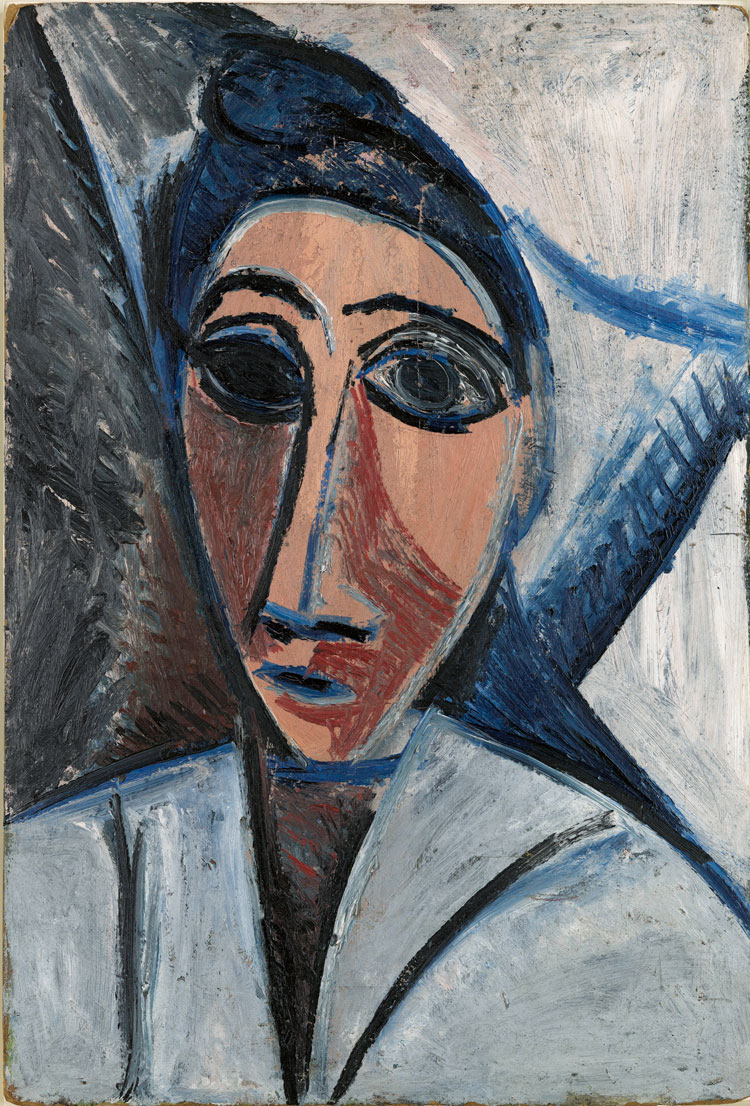
Pablo Picasso, Bust of Woman or Sailor (Study for 'Les Demoiselles d’Avignon'), Paris, spring 1907. Oil on cardboard, 53.5 x 36.2 cm. Musée national Picasso-Paris. Pablo Picasso gift in lieu, 1979. MP15. Photo © RMN-Grand Palais (Musée national Picasso-Paris) / Adrien Didierjean. © Succession Picasso/DACS 2019.
JR: How is the hang of the Picasso show going? Are there any particular highlights?
AD: We are more or less on schedule and it has been very exciting getting all the stuff out of the boxes this week. There are some pretty great works of art. It’s a mammoth show – about 350 works – and full of highlights. I think it will be a bit of a revelation. Unless you go very regularly to the Picasso Museum in Paris (which rotates its collection), you won’t have seen much of this show before.
It covers the whole of Picasso’s career from age nine to his 90s. I’ve kept to a very straightforward, near-chronological structure: early work in Spain, blue period, rose period, a whole room around studies for Les Demoiselles d’Avignon (1907) – generally considered one of the turning-point works in early modern art.
There’s a room of cubism – and papier collé. This exhibition is not so much Picasso on paper as Picasso and paper. It is not just prints and drawings, but everything he did with paper – from sketches on the backs of envelopes to important work on high-quality historic paper made during the French Revolution, studies for major pieces to cut-outs made from red-and-white check tablecloths in Paris cafes.
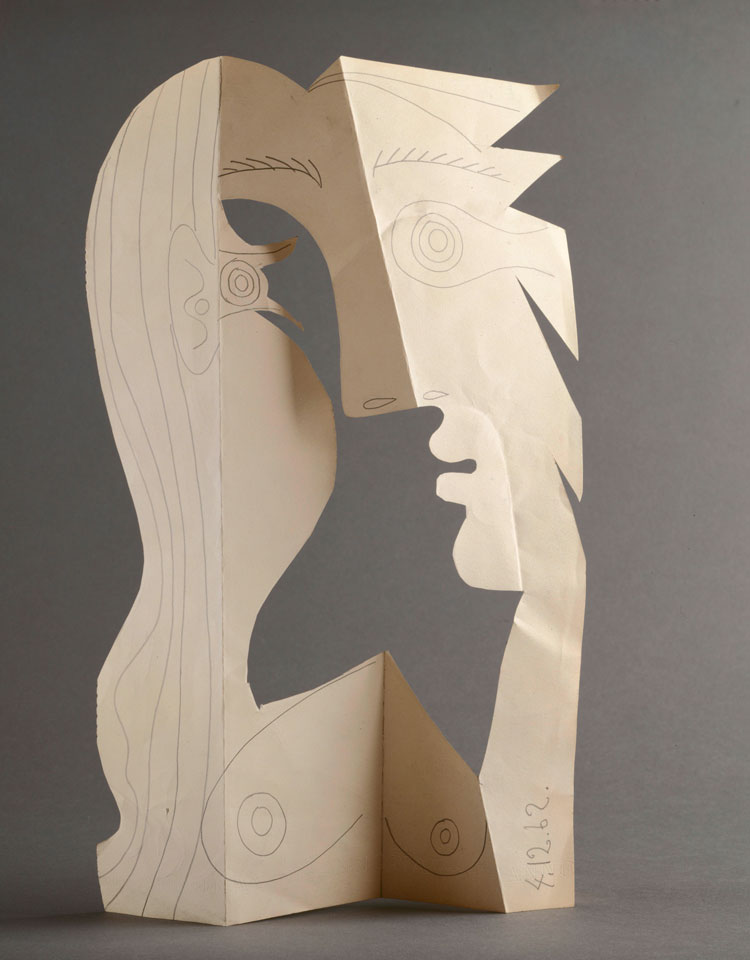
Pablo Picasso, Head of a Woman, Mougins, 4 December 1962. Pencil on cut and folded wove paper from an album sheet, 42 x 26.5 cm. Musée national Picasso-Paris. Pablo Picasso gift in lieu, 1979. MP1850 Photo © RMN-Grand Palais (Musée national Picasso-Paris) / Béatrice Hatala © Succession Picasso/DACS 2019.
We have sketches for his first theatrical work (in 1917), Parade for Diaghilev’s Ballet Russes, which Jean Cocteau asked Picasso to do. Picasso went through a phase around that time when he was really looking at Ingres’ drawings and he does very pure linear neoclassical portrait drawings – which are pretty great – and we have a wall of those.
After that, it’s surrealism – he was never fully a member of the group, but he flirted with it in the early 1930s, which was a period dominated by his relationship with Marie-Thérèse Walter, so we have a big sculpture bust of her. Although the show is about Picasso and paper, we have a sculpture or painting in every room. I wanted to give some scale, and very often his drawings are made as preparation for a sculpture, or drawn at the same time while working out his ideas – it’s a way of looking at his process.
In the late 30s, we come into the period dominated by Guernica. You can never borrow that painting, but we have studies for it. Then we have the highlight of the show, a huge collage called Femmes à Leur Toilette, which hasn’t been in Britain since 1960. It is an amazing thing, very colourful and made entirely of paper.
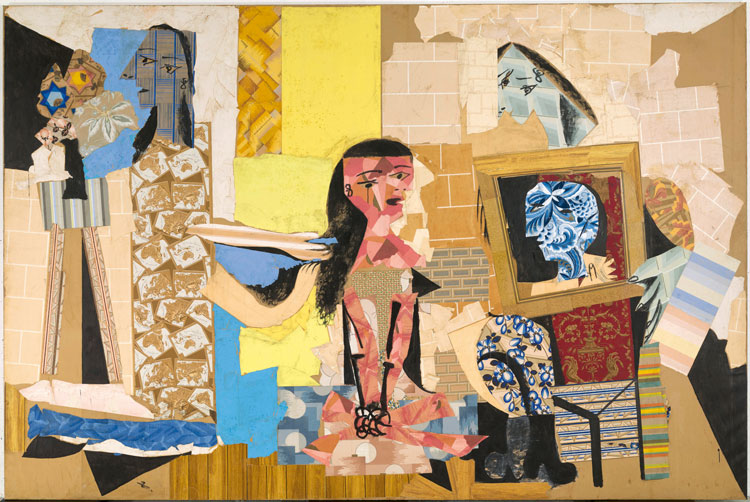
Pablo Picasso, Femmes à leur toilette, Paris, winter 1937–38. Collage of cut-out wallpapers with gouache on paper pasted onto canvas, 299 x 448 cm. Musée national Picasso-Paris. Pablo Picasso Gift in Lieu, 1979. MP176. Photo © RMN-Grand Palais (Musée national Picasso-Paris) / Adrien Didierjean. © Succession Picasso/DACS 2019.
We have a section on the second world war, one on his techniques, and encounters with Manet and Delacroix from the 50s when he was kind of riffing on works by artists he admired. The last rooms cover the final decade of his life, in the South of France, when he was really obsessed with print-making and he does a great series of prints in very experimental ways. And we’ve borrowed his printing press!
Finally, we are showing excerpts from a rather amazing film, Le Mystère Picasso by Henri-Georges Clouzot. Picasso draws on semi-transparent newsprint on a vertical frame with felt-tip pens (newly imported from America) and Clouzot filmed from the other side. The screen is like the canvas or sheet of drawing paper and you see the images taking shape before your eyes. The speed and inventiveness with which Picasso worked are extraordinary. We show one example where he starts out drawing a chicken and that turns into a fish, then into a head. After the film, most of the drawings were destroyed so they would be unique to the film, but about 28 survived and we have two of them.
JR: You are curating a quite different show later in the year – on Paul Cézanne?
AD: That’s a small show, 20 paintings and 12 watercolours – all of rocks and a quarry. It wasn’t my idea. It came from a very distinguished art historian and scholar, John Elderfield. He’s English, but he was chief curator at the Museum of Modern Art in New York and he’s very interested in Cézanne. He did the Cézanne portraits show at the National Portrait Gallery. He’s got very obsessed with Cézanne and has been thinking about and researching the rocks and quarries paintings for some time. So I can’t claim the idea.
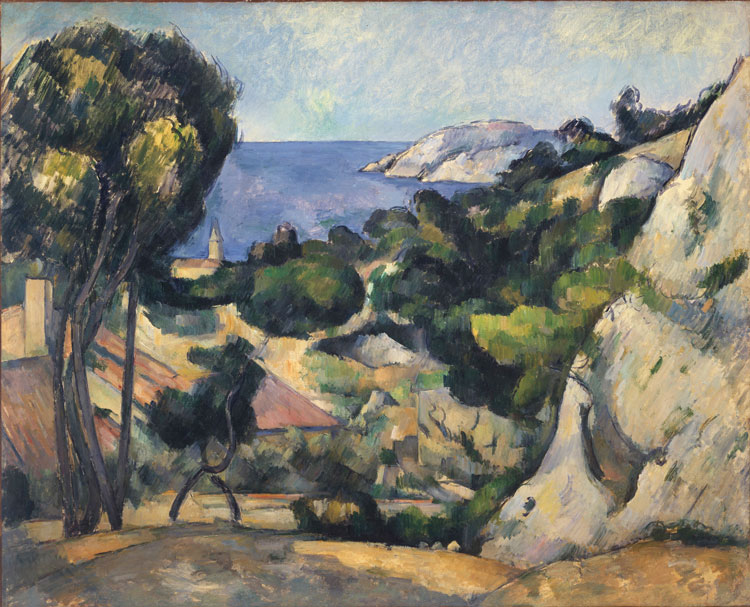
Paul Cézanne, L'Estaque, 1879-83. Oil on canvas, 80.3 x 99.4 cm. The Museum of Modern Art, New York. The William S. Paley Collection, 1959. © 2019. Digital image, The Museum of Modern Art, New York/Scala, Florence.
JR: Has it been interesting to do?
AD: Very. Cézanne was fascinated by rocks. In his class at the Lycée in Aix-en-Provence were Emile Zola and a man called Antoine-Fortuné Marion, who was a geologist and palaeontologist. He ended up as the director of the Natural History Museum in Marseilles. John thinks that he and Cézanne walked around the countryside in Provence picking up fossils and rocks and things. Marion produced an academic book with lots of drawings and there’s a sketchbook by Cézanne where he’s copying some of Marion’s drawings. It was that period in the 19th century when people were joining local geological societies and, certainly, throughout his career, Cézanne chose to depict these very rocky, geological sites with no human presence.
JR: Putting these shows together isn’t simple. Being a curator has a lot of parts, doesn’t it?
AD: [laughing] Yes, I think that’s why I like it. There’s an academic part, a writing/scholarly part, a negotiating part – that’s getting more difficult as there are more and more exhibitions (and I work in an area where the art is particularly popular – Matisse, Monet, Van Gogh). Then the curator works with the exhibition designer, which is quite like theatre design, to turn it all into a tangible experience. Every exhibition is fraught with problems and difficulties – but it’s never dull!
JR: Is it hard to persuade owners to lend their art?
AD: Some are keen, others are not. With museums, there is a process and a quid pro quo, although the RA is at a disadvantage there. We have some great British artists – historically, Thomas Gainsborough, Joshua Reynolds etc, and now David Hockney et al – but we also have the work of a lot of 19th-century artists who are completely forgotten. You can’t offer those in exchange for a Matisse!
If we’re trying to get major loans, I usually go and see the people concerned. I’ve been doing this long enough now that I know most of them. These days, I make a little PowerPoint presentation showing how their work fits into the show and why it’s so important. But that’s only the beginning. There’s a whole internal procedure. Somewhere like the Musée d’Orsay, for instance, may get 30 requests for the same work, so there are loans committees who make the decisions. There are plenty of reasons to say no: pre-existing commitments and importance to the home collection, as well as wear and tear and the work’s fitness to travel. It can easily take nine months just to get a reply.
There is always a period of despair when you think you’ll have to cancel because there are too many refusals, then it all comes together and you can start writing the exhibition panels and labels.
A big part of my job is mediating between the scholarship and the public. Making it all accessible to people who are intelligent and educated, but not art historians. In the end, that is the goal of what we do as curators.
JR: You’ve done a lot of amazing shows. Any favourites?
AD: Yes, I’ve got three or four that meant a lot to me. First, the one that launched my career, which was based on my thesis at the Courtauld on Edgar Degas as a collector. Quite a core of the National Gallery’s 19th-century French painting collection came from Degas’ collection. He died in 1917 and there were seven sales in Paris in 1918 and 1919. Four were his own work – his studio was crammed with his work when he died – and three were of his collection. The economist John Maynard Keynes persuaded the government to give the National Gallery money to go and bid. It bought about 15 works by Ingres and Delacroix (Degas’ favourite artists), Corot and Gaugin. I went to see Neil MacGregor, who was then at the National Gallery, and he agreed to do a small show about the Degas collection.
But I had so much more material. I had contacts in New York and went to see Gary Tinterow at the Metropolitan Museum of Art – he is now my boss in Houston – and he agreed to do a much bigger, more lavish exhibition. They really threw their whole weight behind it and added works by Degas himself. We did this huge, terrific show in 1997 that really got me off the ground.
JR: And the others?
AD: I met the writer Hilary Spurling, who had written the great biography of Matisse. She had done a lot of research into where Matisse grew up – in a rather dreary town in northern France, which was famous in the second half of the 19th century (when Matisse was there) for producing luxury, very colourful silks for the high end of the Paris fashion trade. That was a great discovery and she found all these pattern books. As a child, Matisse was seeing all these colourful things and, as an adult, he went on to collect textiles – not particularly expensive ones, but things he picked up in junk shops. Together, she and I did the RA exhibition, Matisse: His Art and His Textiles.
The other two I would single out would be Painting the Modern Garden: Monet to Matisse (2016), and the one I did in 2010 on Van Gogh and his letters. The Van Gogh Museum in Amsterdam, rather amazingly, lent us 40 of the original letters. (I don’t think they’d do it now – the letters in the Tate’s Van Gogh and Britain exhibition last year were all facsimiles). I chose the ones where he did little sketches to show his brother, Theo, what he was doing. Then the challenge was to get the loans of the paintings to go with the letters.
It was a wonderful project because there were three really great scholars at the Van Gogh Museum at the time who worked for 10 years on the new edition of the letters, which came out to coincide with our show. It’s a great resource that is also online – anyone can look at it. And Van Gogh was so literary. I think he is the greatest artist writer who ever lived.
That show was so moving to work on. His whole life story is so moving, and putting the language together with the paintings was really amazing. I think of all the shows I’ve worked on, that was the one that has meant the most to me.
• Picasso and Paper, curated by Ann Dumas, is at the Royal Academy of Arts, London, from 25 January to 13 April 2020.